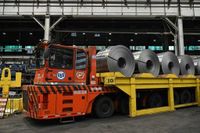On Monday, June 2, 2025, Cleveland-Cliffs Inc. (NYSE: CLF) experienced a dramatic surge in its stock price, rallying by more than 28% to $7.47 in early trading. This remarkable intra-day jump, from a previous close of $5.83, was accompanied by a staggering trading volume of 44.06 million shares—nearly double its average volume—signaling intense investor enthusiasm. The surge was primarily driven by a major political development: U.S. President Donald Trump's announcement late last Friday that steel and aluminum tariffs would be doubled from 25% to 50%, effective June 4, 2025.
The announcement, made at a U.S. Steel facility in Pennsylvania, was a clear effort to protect American steelmakers by curbing foreign competition and boosting domestic production. Trump emphasized that the previous 25% tariff was insufficient, noting, "At 50% nobody's getting over that fence." The increased tariffs are expected to impact a broad range of industries reliant on steel and aluminum, from automotive manufacturing to consumer goods packaging, potentially even affecting grocery prices.
The tariff hike sent shockwaves through the steel industry, with Cleveland-Cliffs leading the charge. Alongside CLF, other U.S. steel companies saw significant gains: Nucor Corp (NYSE: NUE) shares rose about 13%, Steel Dynamics (STLD) gained roughly 11%, and Commercial Metals (CMC) climbed over 8%. Even United States Steel (NYSE: X) saw a 22% increase over the previous week and is up nearly 65% year-to-date. However, broader market indexes reacted cautiously, with Dow Jones Industrial Average futures declining by 0.25% and NASDAQ and S&P 500 futures shedding 0.37% each.
Despite Monday's surge, Cleveland-Cliffs' stock has endured a rough path over recent years. The stock has plummeted approximately 66% over the past year and nearly 76% over the last three years. This decline correlates with a 15% revenue drop in the past twelve months and an average 6% revenue decrease annually from 2022 to 2024. The company's price-to-sales (PS) multiple has also contracted significantly, falling from 1.1x in 2020 to 0.48x in 2023, and currently resting at 0.2x. These metrics underscore the challenges Cleveland-Cliffs has faced amid volatile steel prices and shifting market dynamics.
In the first quarter of 2025, Cleveland-Cliffs reported revenues of $4.6 billion, a modest increase from $4.3 billion in the previous quarter. However, the company posted a net loss of $483 million, equivalent to $1 per diluted share. Management attributed these losses to underutilized non-core assets and the lingering effects of historically low steel prices. In response, Cleveland-Cliffs announced plans to temporarily close several facilities, including two iron mines in Minnesota and multiple steel processing units in Michigan, Pennsylvania, and Illinois. Capital spending on a transformer facility in Weirton, West Virginia, has also been paused. These cost-cutting measures are expected to save over $300 million annually and aim to stabilize operations during this turbulent period.
The steel tariffs come amid a complex competitive landscape. Cleveland-Cliffs recently failed to acquire U.S. Steel, which was instead purchased by Japanese giant Nippon Steel in a deal valued at nearly $14.9 billion. This acquisition includes a substantial $14 billion investment in U.S. Steel’s existing operations and plans for a new steel mill, a move that analysts warn could negatively impact other American steel producers, including Cleveland-Cliffs.
Wall Street's sentiment on CLF remains mixed. Last week, the company suffered two analyst downgrades: Gordon Johnson of GLJ Research lowered CLF to Sell, while Chris LaFemina of Jefferies downgraded it to Hold and cut his price target from $10 to $6, citing competitive pressures from Nippon Steel’s acquisition. Despite this, the consensus analyst rating over the past three months remains Hold, based on a blend of three Buy, five Hold, and one Sell ratings. The average price target stands at about $9.09 to $9.18, implying potential upside of roughly 21% to 57% from the current elevated price levels.
Market technicians are eyeing key resistance and support levels as the stock attempts to consolidate gains. The day’s trading range of $7.00 to $7.50, with $7.50 acting as a crucial short-term resistance, will be closely watched. Additionally, Fibonacci retracement levels at $7.45 and $7.79, along with the 50-day simple moving average around $7.73, offer technical benchmarks for investors assessing momentum.
While the tariff hike has injected optimism into the steel sector, it also raises concerns about broader economic impacts. Research indicates that although the initial 25% tariffs boosted manufacturing jobs in steel and aluminum industries, higher metal costs have slowed hiring in other sectors, potentially dampening overall economic growth. Moreover, the tariffs could strain international trade relationships, prompting retaliatory measures that might affect input costs and downstream demand.
Beyond tariffs, the market is also grappling with geopolitical tensions and government spending cuts. Over the weekend, the U.S. General Services Administration sent letters to major tech companies, including Dell Technologies and CDW Corporation, seeking contract savings and justifications amid ongoing efforts to trim federal expenditures. Defense Secretary Pete Hegseth’s remarks about deterring aggression from Communist China have further fueled market unease, pushing Treasury yields higher and gold prices up over 2% on Monday morning.
For retail investors, Cleveland-Cliffs presents a volatile but potentially rewarding opportunity. The stock’s high beta of 1.85 indicates significant price swings, reflecting both the risks and rewards inherent in the current political and economic environment. The company’s ongoing restructuring efforts, combined with the tariff-driven boost to steel prices, could set the stage for a turnaround if demand stabilizes and operational efficiencies are realized.
Nonetheless, investors should approach cautiously. The company’s negative trailing twelve months earnings per share of -$2.43 and the absence of dividends since April 2020 highlight ongoing profitability challenges. The path to the 52-week high of $17.41 remains steep, requiring sustained operational improvements, favorable market conditions, and positive investor sentiment.
In sum, Cleveland-Cliffs’ explosive stock rally on June 2, 2025, underscores the profound impact of domestic trade policies on the steel industry. While the tariff increase offers a short-term catalyst, the company’s long-term prospects hinge on navigating competitive pressures, managing costs, and capitalizing on market opportunities. As the steel sector recalibrates, investors will be watching closely to see if Cleveland-Cliffs can convert this momentum into lasting gains.





